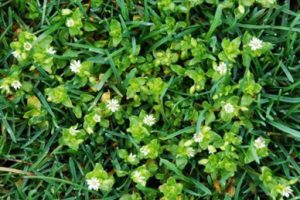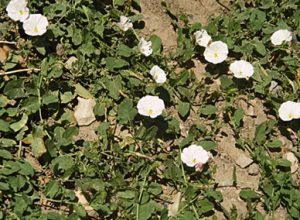Written by Marge Vorndam, Colorado Master Gardener since 1997
Summer is upon us, and most of us are planting and maintaining our ornamental and vegetable gardens. It is a pleasant task filled with personal satisfaction in completing the associated activities. A critical step is maintaining your desired plants while they vie for the same locations as other plants which we do not wish to grow – often referred to as weeds (i.e. “plant out of place.”).
The weeds that we encounter within our gardens have not always been with us. Many were inadvertently introduced to the US, by import, along with desirable crops from other places in the world. Others were brought into cultivation purposefully as they accompanied people who arrived from other lands during the settlement of our country. Many plants that became “weeds” were introduced originally as edible and medicinal crops. Many are still commercially grown for market.
In either event, the pest organisms that exist in the originating lands which would control these plants, did not import with them, and thus, we are tasked with dealing with their spread throughout favorable growing environments, including our gardens. Here, I have gathered the most notable garden invaders. Possibly, you might find a use for those that were intentionally imported, adding to your repertoire of edible plants! Here is an introduction to common garden “weeds”. After being introduced to them, you may find ones that you might consider as a potherb. Origin and potential uses of each plant are included along with other salient features. It is up to the reader to do further research on information provided herein related to plant uses.
This list is organized by scientific name, starting with Family, then Genus and Species. Disclaimer: Many botanical names and Families have been modified due to recent research. The information here is researched circa 1996, notably from “Weeds of the West” (See References).
| Taxonomy Family Genus specific epithet Common name(s) | Notable Characteristics Plant description Origin Uses | Plant Photograph Weblink to Information/Image |
|---|---|---|
| Amaranthaceae Amaranthus blitoides Prostrate pigweed | Annual Prostrate Stems with Taproot Origin-possibly tropical America Edible |  https://ucanr.edu/blogs/UCDWeedScience/blogfiles/53387_original.jpg |
| Asteraceae Matrcaria matricarioides Pineapple-weed | Annual No ray flowers Origin – native Edible |  pineappleweed |
| Asteraceae Taraxacum Verbascum Dandelion | Perennial Milky sap Taproot Origin-Europe Edible |  https://extension.illinois.edu/blogs/flowers-fruits-and-frass/2020-04-17-welcome-dandelion-and-violets-your-lawn |
| Brassicaceae (Cruciferae) Capsella bursa-pastoris Shepherd’s purse | Annual Origin-Europe Heart-shaped seed capsules Blooms April-September Medicinal/Edible |  https://extension.umass.edu/landscape/weeds/capsella-bursa-pastoris |
| Caryophyllaceae Stellaria media Common chickweed Related Cerastiums are found worldwide | Annual Prostrate Deeply notched white petals Edible |  https://turf.purdue.edu/common-chickweed/ |
| Chenopodiaceae Chenopodium album Lambsquarters Goosefoot | Annual Origin Europe Blooms July-September Edible when young |  https://www.mofga.org/resources/greens/lambsquarters/ |
| Chenopodiaceae Kochia scoparia Kochia Tumbleweed | Annual Deep tap root Origin Asia/Europe Blooms July-October Edible when young |  https://www.nwcb.wa.gov/weeds/kochia |
| Chenopodiaceae Salsola iberica Russian thistle Tumbleweed | Annual Origin -Russia Edible when young |  https://www.opsu.edu/Academics/SciMathNurs/NaturalScience/PlantsInsectsOfGoodwell/plants/pasturefiles/pasture22.html |
| Convolvulaceae Convulvus arvensis Field Bindweed Creeping Jenny Morning Glory | Perennial Extensive taproot Origin-Europe Flowering June until Frost Color variations to white/pink flowers CO Noxious Weed List C |  https://ag.colorado.gov/conservation/noxious-weeds/noxious-weed-species/field-bindweed |
| Euphorbiaceae Euphorbia maculata Spotted spurge | Annual Prostrate Milky latex Red spots centered on most leaves |  https://extension.umass.edu/landscape/weeds/euphorbia-maculata |
| Fabiaceae Medicago lupinulina Black medic Hop clover Black trefoil | Annual/perennial Prostrate Taproot Roots fix Nitrogen in soil Origin E. Europe & Asia Flowers April to September Edible/Medicinal |  https://extension.umass.edu/landscape/weeds/medicago-lupulina |
| Geraniaceae Erodium cicutarium Redstem filaree Storksbill | Winter annual or Biennial Blooms in April-May Beaklike fruit Origin – Europe/Asia |  https://www.canr.msu.edu/resources/redstem-filaree-erodium-cicutarium |
| Lamiaceae Lamium amplexicaule Henbit | Winter Annual Square stem Origin-Eurasia, North Africa Flowers-Pink to purple/white flower April to July Edible |  https://turf.purdue.edu/henbit/ |
| Lamiaceae Lamium purpureum Purple deadnettle | Annual Square stem Origin-Europe Blooms in Spring |  https://plants.ces.ncsu.edu/plants/lamium-purpureum/ |
| Lamiaceae Marrubium vulgare White horehound | Perennial 4 sided stems Wooly Origin-Europe Medicinal |  https://www.nps.gov/pinn/learn/nature/invasiveplants.htm |
| Malvaceae Malva neglecta Common mallow Cheeseplant | Annual to perennial Flowers white to light lavender Origin-Europe Medicinal/edible |  https://plants.ces.ncsu.edu/plants/malva-neglecta/ |
| Oxalidaceae Oxalis corniculate Creeping woodsorrel | Perennial Creeping habit Origin-Europe Medicinal/Edible |  http://www.uvm.edu/~hortclub/hortclubweb/weeds/Oxalis%20corniculata%20creeping%20woodsorrel.html |
| Plantaginaceae Plantago lanceolata Buckhorn plantain English plantain | Perennial Leaves basal Origin-Eurasia Flowering May-August Edible |  https://plants.ces.ncsu.edu/plants/plantago-lanceolata/ |
| Poaceae Elytrigia repens Quackgrass | Perennial Spreads from seeds or rhizomes Origin-Eurasia Colorado Noxious Weed List C species |  https://www.carboncountyweed.com/?attachment_id=619 |
| Polygonaceae Rumex acetosella Red sorrel Sheep’s sorrel | Perennial Origin-Europe Lower leaves can be lobed and arrow-shaped Edible/Medicinal |  http://blogs.ifas.ufl.edu/escambiaco/2021/03/31/weekly-what-is-it-red-sorrel/ |
| Portulacaceae Portulaca oleracea Common purslane Portulaca | Annual Taproot Fleshy prostrate Small yellow flowers bloom late Origin-Europe High vitamin A Edible/Medicinal |  https://plants.ces.ncsu.edu/plants/portulaca-oleracea/ |
References
See weblink listed below specific “weed” Photograph.
Burrill, et al., 1996. Weeds of the West. University of Wyoming Agricultural Extension. Laramie, WY.
Colorado Department of Agriculture. ND. Noxious Weed Species ID. https://ag.colorado.gov/conservation/noxious-weeds/species-id


